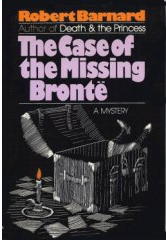Sat 30 Jan 2010
A Movie Review by Walter Albert: JANE EYRE (1944).
Posted by Steve under Films: Drama/Romance , Reviews[6] Comments
JANE EYRE. 20th Century-Fox, 1944. Orson Welles, Joan Fontaine, Margaret O’Brien, Peggy Ann Garner, John Sutton, Sara Allgood, Henry Daniell, Agnes Moorehead, Aubrey Mather, Edith Barrett, Mrs. Fairfax, Barbara Everes, Hillary Brooke. Screenplay: John Houseman, Aldous Huxley, Robert Stevenson & Henry Koster (the latter uncredited), based on the novel by Charlotte Brontë. Director: Robert Stevenson.

Last night as I sat up until 2:00 a.m. engrossed in a showing of the 20th Century Fox version of Jane Eyre, I alternately cursed the frequent interruptions for the promotion of albums like Motels & Memories and local entrepreneurs like Mother’s Pizza (“Just like you remember it, only it really wasn’t ever this good!”) and revelled in the superb Dickensian detail of the sequences at Linwood School dominated by Henry Daniell’s marvelous portrayal of the sadistic religious fanati,c, Broadhurst.
I was moved by the moody, romantic sweep of the episodes at Rochester’s estate, with the brilliant portrayal of mad Mrs. Rochester’s husband by Orson Welles, supported by one of composer Bernard Herrmann’s finest scores.
The film is one of those meticulous re-creations of a literary classic that David Selznick, in particular, was gifted in bringing to life on the screen, but it has, at moments, something which such films often do not have: imaginative camera work which makes portions of the film seem as fresh as they did thirty-five years ago and confirms for me the rumors that Welles, coming to this project after Citizen Kane and the abortive Magnificent Ambersons, co-directed certain scenes.

I thought I detected Wellesian touches in Jane’s introduction to Rochester at the manor; in the handling of the brief scene with Agnes Moorehead at the beginning as the camera in a sardonic low-angle shot accented the self-satisfied cruelty of Jane’s aunt and cousin; and in the exterior shots of the great house that squats malevolently at the film’s center, with its battlements and moody lighting that inevitably remind the viewer of Kane’s estate.
You will get some idea of the quality of the team that was assembled for this film when I tell you that two of the script-writers were Aldous Huxley and John Houseman and that, in addition to Welles, Daniell, Moorehead, and Joan Fontaine (as Jane), there are splendid performances by a group of actors that can only serve to remind us of the talent that was still available to the major studios in the early forties: Elizabeth Taylor, Peggy Ann Garner, Margaret O’Brien, Sara Allgood, John Sutton (in an uncommonly fine portrayal of Broadhurst’s sympathetic alter ego, Dr. Rivers), and other players whose names are less familiar but whose faces are indelibly imprinted on our memories of films of the period.

I was struck by the beauty of a line delivered by Welles as he described Jane’s first sight of Mrs. Rochester, “Look at Jane, all grave and silent at the mouth of Hell,” and bothered by the jarring modernity of another line describing Mrs. Rochester after her fatal leap as she “lay smashed on the pavement.”
I was riveted by a shot of Moorehead looking like a grinning Medusa and by the long shot of the wedding ceremony with the ominous entrance of an unseen “Guest” glimpsed only at first as a shadow slipping by against a shaft of light suddenly striking a sacristy wall.
And I was intrigued by the obvious attempt to introduce fairy-tale elements into the narrative, with the climax clearly using devices from “Beauty and the Beast” that could not have been accidental.
In short, I was overwhelmed by the intelligence, craftsmanship, and beauty of this film and reminded that film history is filled with superb movies that are often only entries in an edition of Movies That May Be Seen as Interruptions of Late-Night TV Commercials.







